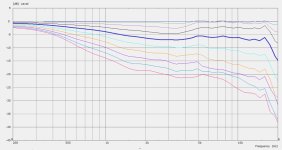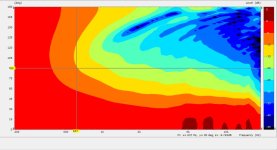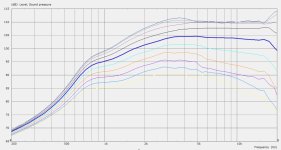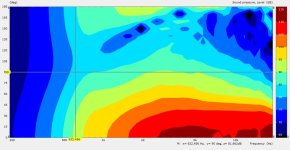Don't think of the extension as something that extends into the waveguide (then it would have a rather strong effect on directivity). It's the opposite, it extends "into" the source, with the duct diameter only smaller than the original throat.
You could make throat angle (a0) variable, negative at the sides, perhaps used together with the morph feature. I have never tried.For the 3D approach I have no idea how to make the slots at the side pinch into the throat profile, which the PT and the GGNTKT waveguides have in common. But maybe someone has an idea.
There's also the "slot" feature, which I already don't know how to use...
You would have to explain to me how that works first, because the "phase trace" is directly tied to the magnitude response - in a sense, it's one and the same thing here. Including a crossover, with the same desired acoustic magnitude responses, both phase responses would be also the same (if not intentionally manipulated separately). So it's not clear to me what's the value, or how could it indicate anything...Mabat, is it possilbe to include the phase trace?
It gives an indication of how low they can be crossed.
- I would look at distortion figures if I wanted to know the LF limits - that's what I plan to do, but it needs to be done more carefully and requires some preparation, as I probably don't have a very good microphone for that.
I hoped we would see more results and findings from others, as I just can't do it all myself, but maybe it's all in the making yet 🙂
Last edited:
That's cute. I regularly fail to produce substantial results with it as well.There's also the "slot" feature, which I already don't know how to use...
I used to make k variable for different reasons until I realized that by this, the throat was not circular anymore and became oval, partially obstructed by the waveguide. Never thought about throat angle, will try it. But this protrusion of the slots could also be something which is not achieveable at all. Any leads welcome.
You are right. Distortion is a better factor.You would have to explain to me how that works first, because the "phase trace" is directly tied to the magnitude response - in a sense, it's one and the same thing here. Including a crossover, with the same desired acoustic magnitude responses, both phase responses would be also the same (if not intentionally manipulated separately). So it's not clear to me what's the value, or how could it indicate anything...
- I would look at distortion figures if I wanted to know the LF limits - that's what I plan to do, but it needs to be done more carefully and requires some preparation, as I probably don't have a very good microphone for that.
I hoped we would see more results and findings from others, as I just can't do it all myself, but maybe it's all in the making yet 🙂
Here is a comarison of BMS 4550 on two horns of relatively same size
Now the numbers here are all relative, but it's clear that the exponential horn is usable lower.
Another thing to notice is the HF boost since the exponential horn also beams..
Blue trace is somewhat exponential
Black trace is somewhat OS
Yes, that's a good example. Using 'somewhat exponential', you can easily get e.g. from 800-900 to 500-600 Hz but at the cost of increased beaming. Now try to use an extension tube, as it should provide about the same LF extension but without any loss of pattern control.
It may "only" require a suitable driver...
It may "only" require a suitable driver...
Last edited:
I'll make two horns of identical size, one of them with 1" throat and one with 1.4" and see what's up.
I think the BMS 4550 has a 7 degree conical exit. It should be a good candidate.
I think the BMS 4550 has a 7 degree conical exit. It should be a good candidate.
I finally figured out how to get AKABAK running with an elliptic round over profile. The results below are have 10 deg increments from 0-90. Thanks for the unbelievable resource of information Marcel and giving an amazing reference point to copy! Look like I've got a workable scheme to start fabricating
Attachments
For those willing to print it and try, here's a modified ST260. This outer shape is actually the direct result of the formulas used. I have also a version with a truly round (flat) mouth but this performs better so I left it as it is.
View attachment 1077663View attachment 1077664View attachment 1077667
STL for download: https://at-horns.eu/ext/ST260-BLD-mres.zip
The first Horn is ready 🙂
Thank you for this nice work
Hello Mabat,
do you think it was a bad idea?
I like the look of this design very much and i have the perfect color for it buyed.
Pink matte will be my choice 😉
Greets Hannes
do you think it was a bad idea?
I like the look of this design very much and i have the perfect color for it buyed.
Pink matte will be my choice 😉
Greets Hannes
No, not at all. It will be interesting to see it actually tested with a real driver (at least I can't recall any other tries).
- It's just that the latest extended devices seem so much better...
- It's just that the latest extended devices seem so much better...
Well the ones from the last several pages, like this one: https://www.diyaudio.com/community/...-design-the-easy-way-ath4.338806/post-7435751
See also the measurements made by @maravedis.
It's actually not so much bigger but should offer quite a substantially lower usable frequency...
See also the measurements made by @maravedis.
It's actually not so much bigger but should offer quite a substantially lower usable frequency...
The idea is to start with as small exit diameter as possible on the source side. The published horn (400-25/36) has a 1" throat, expanding to 1.4" where the "actual" WG starts, which still seems acceptable. You could scale the whole device 1.4x but then you would effectively end up with a 2" throat. So the idea with 1.4" drivers was to use them right from the phase plug exit, if possible. I would be reluctant to make a 2" throat waveguide - too much of the inevitable HF beaming, IMO.
It should not be a problem to take any of the ATHEX waveguides and to add a conical extension to any of those (and scale if needed), preferably to be connected directly to the exit of a phase plug (being it a 1.4" or 2" driver). As I'm still not sure how the extension really works with conjunction with any particular driver, I would have to guess as well...
It should not be a problem to take any of the ATHEX waveguides and to add a conical extension to any of those (and scale if needed), preferably to be connected directly to the exit of a phase plug (being it a 1.4" or 2" driver). As I'm still not sure how the extension really works with conjunction with any particular driver, I would have to guess as well...
Last edited:
- I already tried a big 2" driver with a simple conical connector and it worked very well, I really liked the sound:
https://www.diyaudio.com/community/...-design-the-easy-way-ath4.338806/post-7437739
There's simply something to the "full-bodied" reproduction from one driver. You won't hear that very often.
https://www.diyaudio.com/community/...-design-the-easy-way-ath4.338806/post-7437739
There's simply something to the "full-bodied" reproduction from one driver. You won't hear that very often.
Then you can try to insert a conical connector for the ATHEX 460-36 (as I did), or scale the 460-25 if you want even a bigger waveguide.
Thank you for the info, maybe this can be the next horn for me.Well the ones from the last several pages, like this one: https://www.diyaudio.com/community/...-design-the-easy-way-ath4.338806/post-7435751
See also the measurements made by @maravedis.
It's actually not so much bigger but should offer quite a substantially lower usable frequency...
- Home
- Loudspeakers
- Multi-Way
- Acoustic Horn Design – The Easy Way (Ath4)



